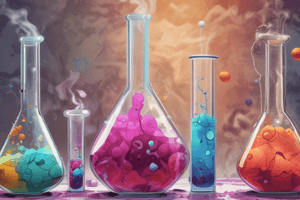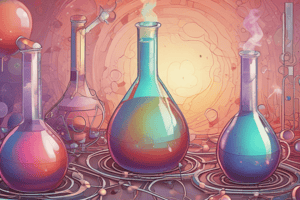Podcast
Questions and Answers
What is the type of reaction where a single compound breaks down into two or more substances?
What is the type of reaction where a single compound breaks down into two or more substances?
- Replacement Reaction
- Synthesis Reaction
- Combustion Reaction
- Decomposition Reaction (correct)
What is the purpose of coefficients in a chemical equation?
What is the purpose of coefficients in a chemical equation?
- To indicate the mole ratio of the substances in the reaction (correct)
- To indicate the reactants and products of a reaction
- To determine the outcome of a reaction
- To calculate the quantity of reactants and products
What is the first step in balancing a chemical equation?
What is the first step in balancing a chemical equation?
- Add coefficients to balance the equation
- Count the atoms of each element on both sides
- Check the equation to ensure it is balanced
- Write the unbalanced equation (correct)
What is the purpose of chemical equations in predicting the outcome of a reaction?
What is the purpose of chemical equations in predicting the outcome of a reaction?
What type of reaction involves the replacement of one element with another in a compound?
What type of reaction involves the replacement of one element with another in a compound?
What is the last step in balancing a chemical equation?
What is the last step in balancing a chemical equation?
What are the substances that are present at the start of a reaction?
What are the substances that are present at the start of a reaction?
What is the type of reaction where a substance reacts with oxygen to produce heat and light?
What is the type of reaction where a substance reacts with oxygen to produce heat and light?
Flashcards are hidden until you start studying
Study Notes
Types of Chemical Reactions
- Synthesis Reaction: A reaction where two or more substances combine to form a new compound.
- Example: 2H2 + O2 → 2H2O
- Decomposition Reaction: A reaction where a single compound breaks down into two or more substances.
- Example: 2H2O → 2H2 + O2
- Replacement Reaction: A reaction where one element replaces another element in a compound.
- Example: Zn + CuSO4 → ZnSO4 + Cu
- Combustion Reaction: A reaction where a substance reacts with oxygen to produce heat and light.
- Example: 2CH4 + 3O2 → 2CO2 + 3H2O
Chemical Equations
- Reactants: The substances that are present at the start of a reaction.
- Products: The substances that are formed as a result of a reaction.
- Coefficients: Numbers that are placed in front of formulas of reactants or products to indicate the mole ratio of the substances in the reaction.
- Balancing Equations: The process of adding coefficients to ensure that the number of atoms of each element is the same on both the reactant and product sides.
Steps to Balance a Chemical Equation
- Write the unbalanced equation: Write the reactants and products with their respective formulas.
- Count the atoms: Count the number of atoms of each element on both the reactant and product sides.
- Add coefficients: Add coefficients to balance the equation by ensuring that the number of atoms of each element is the same on both sides.
- Check the equation: Check the equation to ensure that it is balanced and that the coefficients are in the lowest possible ratio.
Importance of Chemical Equations
- Predicting the outcome of a reaction: Chemical equations allow us to predict the products and reactants of a reaction.
- Determining the quantity of reactants and products: Chemical equations allow us to calculate the amount of reactants required and the amount of products formed.
- Understanding chemical reactions: Chemical equations help us understand the mechanism of chemical reactions and the interactions between molecules.
Types of Chemical Reactions
- A Synthesis Reaction combines two or more substances to form a new compound, e.g., 2H2 + O2 → 2H2O.
- A Decomposition Reaction breaks down a single compound into two or more substances, e.g., 2H2O → 2H2 + O2.
- A Replacement Reaction replaces one element with another in a compound, e.g., Zn + CuSO4 → ZnSO4 + Cu.
- A Combustion Reaction reacts a substance with oxygen to produce heat and light, e.g., 2CH4 + 3O2 → 2CO2 + 3H2O.
Chemical Equations
- Reactants are the substances present at the start of a reaction.
- Products are the substances formed as a result of a reaction.
- Coefficients are numbers that indicate the mole ratio of substances in a reaction.
Balancing Chemical Equations
- Step 1: Write the unbalanced equation, including reactants and products with their formulas.
- Step 2: Count the atoms, counting the number of atoms of each element on both the reactant and product sides.
- Step 3: Add coefficients, balancing the equation by ensuring the number of atoms of each element is the same on both sides.
- Step 4: Check the equation, verifying that the equation is balanced and the coefficients are in the lowest possible ratio.
Importance of Chemical Equations
- Predicting the outcome of a reaction, allowing us to anticipate products and reactants.
- Determining the quantity of reactants and products, enabling calculations of required reactants and formed products.
- Understanding chemical reactions, helping us comprehend the mechanism of chemical reactions and molecular interactions.
Studying That Suits You
Use AI to generate personalized quizzes and flashcards to suit your learning preferences.




